There are perches and then there are… perches.
- Note: I was far away from these birds so these photos have been significantly cropped and as a result the image quality isn’t great (though it’s not bad considering the large crop). All but the last shot have been cropped to exactly 30% of the original image and the last one has been cropped to 33.5%.
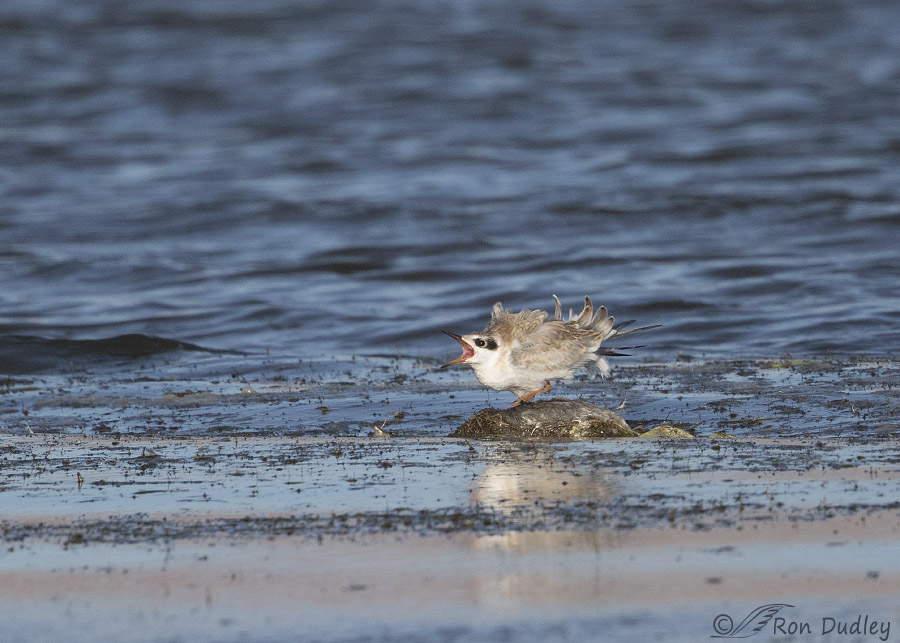
Three days ago I photographed a juvenile Forster’s Tern as it was being fed a fish by one of its parents at Bear River Migratory Bird Refuge. The youngster’s perch is unique and I thought a little morbid – it’s a dead coot. The coot is on its back with the tip of its beak sticking up at left and its feet on the right. In over an hour the coot didn’t move in the stiff breeze (which is ruffling the feathers of the juvenile) so it must have been grounded in the shallow water.
The young tern was displaying begging behavior the entire time I was with it but here it has just spotted one of its parents coming in with a fish so its begging and calling intensified dramatically.
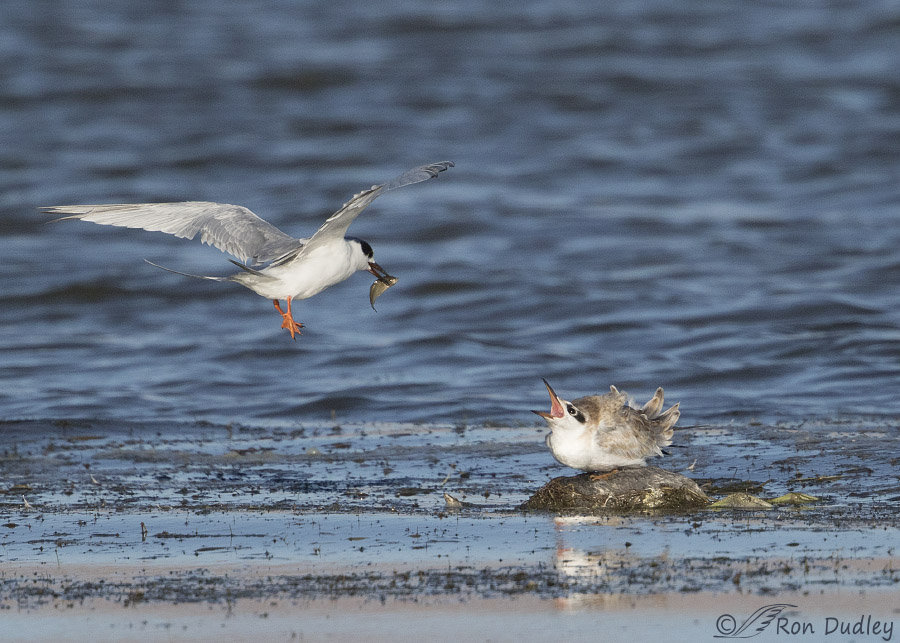
The adult has what may be a very small carp in its beak. Interestingly, studies have shown that Forster’s Terns deliberately correlate the size of the fish to the size of their young – smaller fish to smaller offspring.
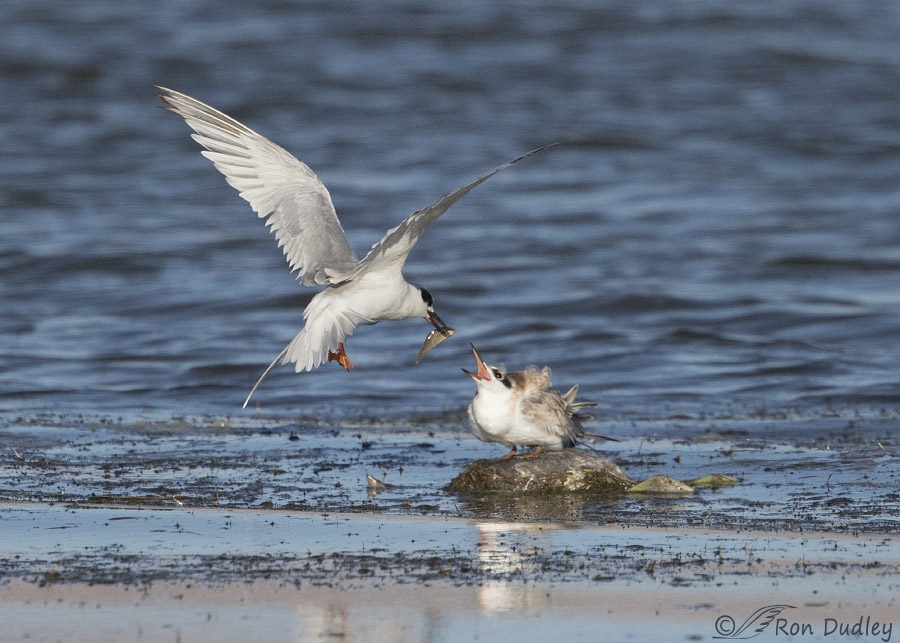
The adult was quite delicate in its delivery. Even though its wings were beating furiously as it was hovering…
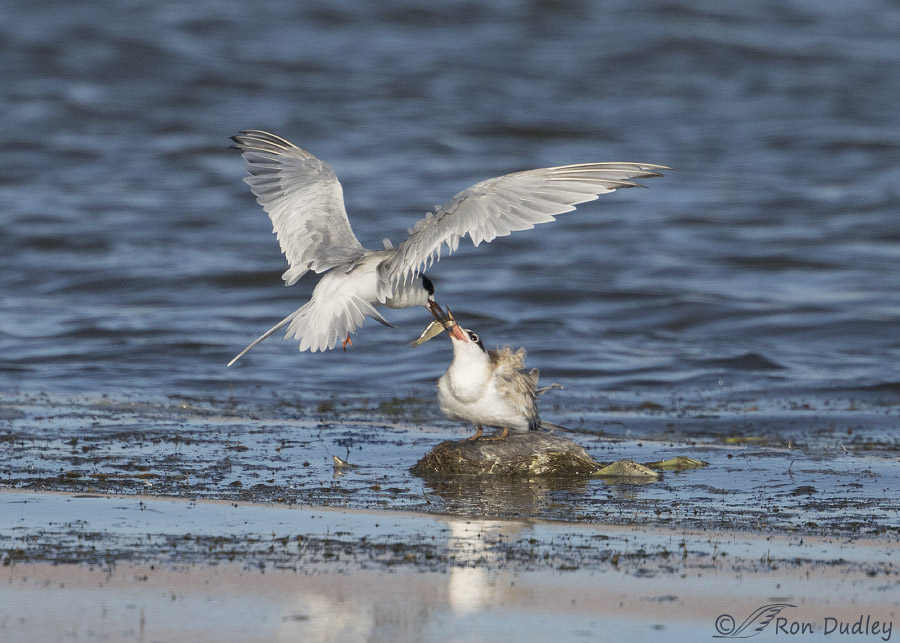
it was very careful to make sure the awkward youngster had the fish securely it its beak…
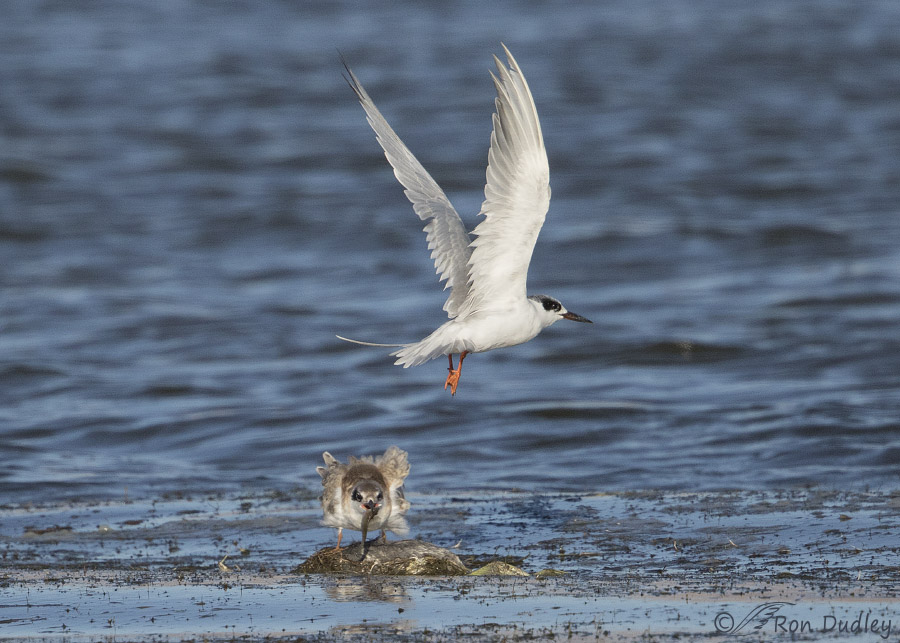
before flying off. The juvenile gobbled the fish down quickly.
Despite having to heavily crop these images I’m still happy to have them for the behavior they illustrate and for their uniqueness. After all, photos of Forster’s Terns feeding fish to a youngster on the carcass of a dead coot don’t come along every day…
Ron
PS – When there’s wind most perched birds align their bodies so they’re facing into the wind but this juvenile had its butt to the wind the entire time (thus the severely ruffled feathers). I had to wonder if that was instinctual behavior specific to this feeding situation to make it easier for the adult with food to hover in front of the youngster. I’m thinking that it likely was and if so it’s just more bird behavior I find fascinating…
Note to photographers: These photos were just a bit of a challenge to rotate to level. The temptation was to rotate based on one of the nearly horizontal bands of detritus in the water because at first our eye tells us that should be level but those bands were actually running slightly obliquely to me so they were a little deceiving. I chose to rotate to try to get the floating coot level which is as it should be but the detritus bands may still lead our eyes astray, especially in some of the earlier images.



such an interesting series. Thanks
I just LOVE behavioral shots/series. Seriously, I do (and you know that!)! Across most species, parenting is serious business (guppies and sea turtles, among others, are excluded from this conversation!) and they do a spectacular job. And while I’m not an -ologist of any sort, I have NO doubt whatsoever that the kiddo placed itself against the wind at the behest of the parent who deliberately came in from that direction to make the act of hovering to feed the youngster much easier. And in that act of forcing the issue, so to speak, the parent provided yet another learning opportunity. The other deliberate act, choosing the correct size meal to fit the kid’s needs would definitely be a parent kind of thing to do. Certainly Big Red (female redtail hawk at the Cornell Redtail Hawk nest cam) made the tidbits she fed her kids the right size for them from their first meals onward until it was time for them to feed themselves.
As for the morbid perch, it was there and all bearing in mind ports in storms and such–and kids
You always make some interesting observations, Laura.
I just believe we’re all far more alike than we are different. It doesn’t surprise me in the least that parents act like parents, on a bell curve from excellent to poor of course, across species. I also believe in the intelligence of other species, that instinct is perfect intelligence installed at the factory, and that when added to experiential learning, creates what we call intelligence. We’d do far better as a species if we didn’t disrespect and dismiss our instincts and if we took the time to learn from other species instead of dismissing them as less than us. But I’m a heathen.
“But I’m a heathen. ” Join the group. Laura! We have snacks!
” Join the group. Laura! We have snacks! 
How I love the practical and pragmatic attitude of the terns. And learning. And marvelling.
Megathanks.
Thank you, EC.
I gotta say it to get it out of the way: poor little coot! These are fabulous shots, Ron! I like the way the youngster hunkers down as the parent approaches and raises only its front end to meet the fish. I wonder if that has anything to do with the slightly awkward perch or if that’s an every time occurrence. The last head-on shot is priceless: “Mine! All mine! Gobble, gobble.”
These are fabulous shots, Ron! I like the way the youngster hunkers down as the parent approaches and raises only its front end to meet the fish. I wonder if that has anything to do with the slightly awkward perch or if that’s an every time occurrence. The last head-on shot is priceless: “Mine! All mine! Gobble, gobble.” 
It’s my guess that it’s an “every time occurrence”, Marty, but who knows – perhaps if it was competing for that fish with a sibling on the nest it might be different,
These are neat behavior shots Ron! Having lived on the coast for over 40 years and banding terns for 20 some odd years it is truly amazing the size of the fish chicks can gobble down. Thanks for the post!
Thank you, Dick.
Ron, I just love the photo series, them comments, and the education. Thank you. A couple of “I never knew’s” there.
The juvenile facing away from the wind was a “never knew” for me too, Richard. Thanks.
This is a wonderful series of images, large crop or no. The leveling makes perfect sense to me, and in looking at all the shots, none of them felt like they were off balance. I love that the burst speed on your camera can bring something that probably happened very quickly into slow motion.
I love the fast burst rate of the newer cameras these days, Susan – especially for birds!
Yuk!
Patty, you’re funny!
Ron, Wow, what a great observation on your part re the alignment of the chick to accommodate the approaching adult. Not being a vial behaviorist, I have to make the assumption you are correct, and I can find no other explanation. That is really cool! Thank you for that!
I’m not sure I’m right about that behavioral observation, Frank, but it sure seems logical to me.
Wonderful series Ron – even with the dead coot which, obviously, wasn’t at all meaningful to the Tern! Being locked in on the Tern I probably wouldn’t have paid much attention to what the perch was……….:) Obviously it was of no interest to either the young or adult Tern!
Thanks, Judy. It was hard for me to ignore that dead coot as the perch, especially before the feeding behavior began.